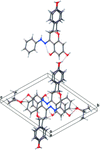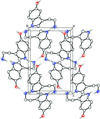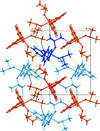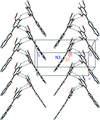issue contents
April 2022 issue

Cover illustration: Hybrid organic–inorganic halide salts have long been studied for optoelectronic applications because of their versatile photophysical properties combined with the tunability of their electronic and crystal structures. In particular, research has focused on engineering hybrid halometallate salts with large organic cations to improve air, moisture and thermal stability. Against this background, three new isomorphous 0-D hybrid salts of general formula [L]2[MCl4] (L = imidazo[1,5-a]pyridinium-based organic cation, M = Zn, Cd, X = Cl, Br, I), namely, 2-methylimidazo[1,5-a]pyridinium trichloridoiodidozincate(II), 2-methylimidazo[1,5-a]pyridinium dibromidodichloridocadmate(II) and 2-methylimidazo[1,5-a]pyridinium trichloridoiodidocadmate(II), have been synthesized and characterized both structurally and spectroscopically. See Vassilyeva, Buvaylo, Kokozaya & Skelton [Acta Cryst. (2022). E78, 359–364].
research communications


















































 journal menu
journal menu











































